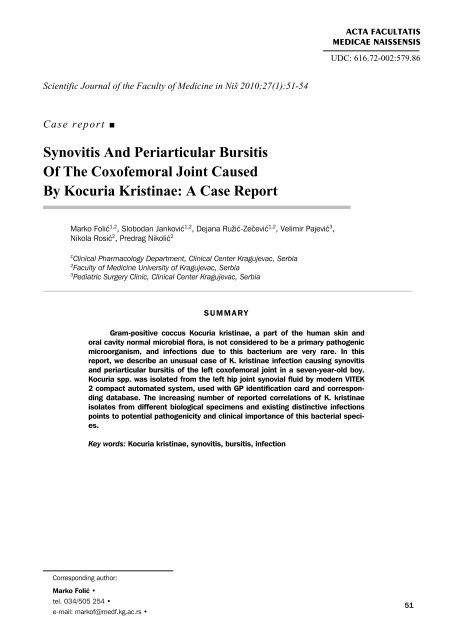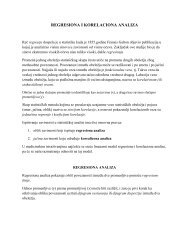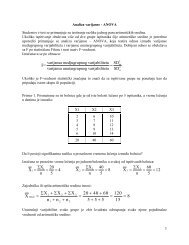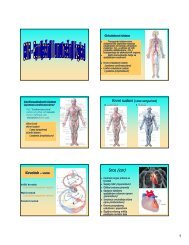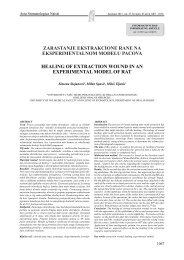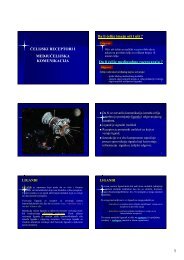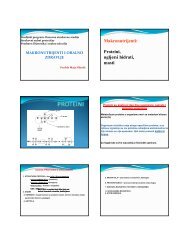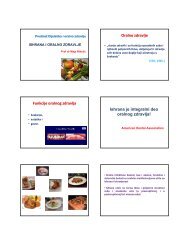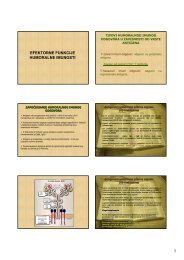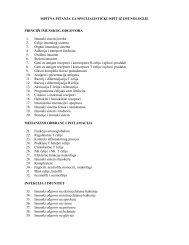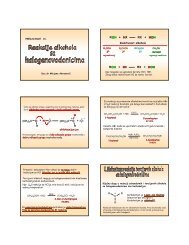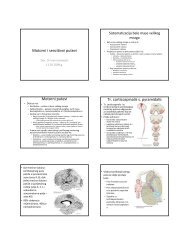Synovitis And Periarticular Bursitis Of The Coxofemoral Joint ...
Synovitis And Periarticular Bursitis Of The Coxofemoral Joint ...
Synovitis And Periarticular Bursitis Of The Coxofemoral Joint ...
You also want an ePaper? Increase the reach of your titles
YUMPU automatically turns print PDFs into web optimized ePapers that Google loves.
Scientific Journal of the Faculty of Medicine in Niš 2010;27(1):51-54<br />
Case report ■<br />
<strong>Synovitis</strong> <strong>And</strong> <strong>Periarticular</strong> <strong>Bursitis</strong><br />
<strong>Of</strong> <strong>The</strong> <strong>Coxofemoral</strong> <strong>Joint</strong> Caused<br />
By Kocuria Kristinae: A Case Report<br />
Marko Folić 1,2 , Slobodan Janković 1,2 , Dejana Ružić-Zečević 1,2 , Velimir Pajević 3 ,<br />
Nikola Rosić 2 , Predrag Nikolić 2<br />
1 Clinical Pharmacology Department, Clinical Center Kragujevac, Serbia<br />
2 Faculty of Medicine University of Kragujevac, Serbia<br />
3 Pediatric Surgery Clinic, Clinical Center Kragujevac, Serbia<br />
Corresponding author:<br />
SUMMARY<br />
Gram-positive coccus Kocuria kristinae, a part of the human skin and<br />
oral cavity normal microbial flora, is not considered to be a primary pathogenic<br />
microorganism, and infections due to this bacterium are very rare. In this<br />
report, we describe an unusual case of K. kristinae infection causing synovitis<br />
and periarticular bursitis of the left coxofemoral joint in a seven-year-old boy.<br />
Kocuria spp. was isolated from the left hip joint synovial fluid by modern VITEK<br />
2 compact automated system, used with GP identification card and corresponding<br />
database. <strong>The</strong> increasing number of reported correlations of K. kristinae<br />
isolates from different biological specimens and existing distinctive infections<br />
points to potential pathogenicity and clinical importance of this bacterial species.<br />
Key words: Kocuria kristinae, synovitis, bursitis, infection<br />
Marko Folić •<br />
tel. 034/505 254 •<br />
e-mail: markof@medf.kg.ac.rs •<br />
ACTA FACULTATIS<br />
MEDICAE NAISSENSIS<br />
UDC: 616.72-002:579.86<br />
51
ACTA FACULTATIS MEDICAE NAISSENSIS, 2010, Vol 27, No 1<br />
52<br />
INTRODUCTION<br />
Kocuria is reclassified and clearly separated<br />
genus, segregated from the genus of Micrococcus<br />
several years ago, based on the results of a phylogenetic<br />
and chemotaxonomic analysis (1). <strong>The</strong> genus was<br />
named in honor to Miroslav Kocur, a microbiologist from<br />
Slovakia, who dedicated a lot of his work to studying<br />
Micrococcus luteus (2,3). Kocuria usually can be isolated<br />
from the human skin and oral cavity, but its normal<br />
habitats include soil, rhizoplane and fresh water (4).<br />
Currently, there are thirteen known species of Kocuria.<br />
K. kristinae (formerly known as Micrococcus kristinae),<br />
one of the members of Kocuria spp. is gram-positive,<br />
aerobic, non - encapsulated, non - endospore - forming,<br />
non-halophilic coccus occuring in tetrads (1). Although,<br />
like other Kocuria species, K. kristinae was not considered<br />
to be a primary pathogen, during recent years<br />
there have been well-documented reports of catheterrelated<br />
bacteriemia due to this species in a patent with<br />
ovarian cancer (5) and acute cholecystitis with K. kristinae<br />
isolated from bile (6). In this article, we report a<br />
case of seven - year - old boy with synovitis and periarticular<br />
bursitis of the left coxofemoral joint and K.<br />
kristinae isolated from synovial fluid of the inflamed<br />
joint.<br />
CASE REPORT<br />
A seven-year-old boy was presented with a strong<br />
pain in the region of the left hip for three days, followed<br />
with fever, and admitted to hospital. During the first<br />
clinical examination, resistance to left hip flexion and<br />
abduction was also found. Blood tests showed elevation<br />
of inflammatory markers such as C-reactive protein-<br />
CRP (44.5 mg/L), fibrinogen (5.264 g/L) and sedimentation<br />
rate (first hour - 83 mm), while white blood cells<br />
(WBC) count was normal. Aspiration of the left coxofemoral<br />
joint was also done, but the culture of synovial<br />
fluid was without result. <strong>The</strong> antibiotic combination of<br />
cephazolin and clindamycin was administered to the<br />
patient. A clinical and laboratory improvement including<br />
withdrawal of distinctive pain and resolution of fever<br />
ensued in the next few days. <strong>The</strong> blood cultures were<br />
negative. However, ten days after admission to hospital,<br />
the child became febrile again, with body temperature<br />
reaching 40.3 degrees of Celsius. New blood tests<br />
revealed increase of inflammatory indicators (CRP was<br />
15 mg/L, fibrinogen level - 5.0 g/L, sedimentation rate-<br />
first hour - 92 mm), accompanied with leukocytosis<br />
(WBC count was 18.3 x 10 9 /L, with dominance of<br />
granulocytes - 86.3%). A stool culture and a new blood<br />
culture were done, but the results were negative.<br />
Immunologic analysis of blood samples excluded patient’s<br />
immunodeficiency. Chest X-ray did not show any<br />
inflammatory changes in the lungs. In the meantime,<br />
the child started to feel pain in the region of the left hip<br />
again, with tendency to avoid movements. Ultrasono-<br />
graphy and magnetic resonance imaging of the left<br />
coxofemoral joint revealed accumulation of fluid in the<br />
joint capsule and periarticular bursa (Figure 1), without<br />
any visible changes of bone and muscular structures.<br />
Figure 1. Ultrasonography of the affected joint<br />
<strong>The</strong> joint was aspirated again and the aspirate was<br />
cultured. An unusual and unexpected gram-positive coccus,<br />
Kocuria kristinae, was grown and identified by<br />
bioMérieux VITEK 2 compact automated system, using<br />
gram-positive (GP) identification card and corresponding<br />
database. <strong>The</strong> patient was treated with vancomycin for<br />
7 days, and with teicoplanin for the next week. All clinical<br />
signs and subjective symptoms resolved and full recovery<br />
ensued, followed by normalization of blood tests.<br />
DISCUSSION<br />
Synovial membrane is a soft, tiny layer of tissue<br />
that lines the cavities of freely movable joints, tendon<br />
sheaths, bursae and makes synovial fluid, which has a<br />
lubricating function, provides cushioning and prevents<br />
wear and tear of the skin, muscles, tendons and ligaments<br />
over bones. Inflammation of synovial membrane<br />
is a painful condition with production of excess fluid<br />
and caused by irritation from overuse, injury, gout,<br />
pseudogout, rheumatoid arthritis or certain infections.<br />
<strong>The</strong> most common pathogenic microorganism that<br />
induces this condition is Staphylococcus aureus (7).<br />
Kocuria kristinae is part of the skin and oral cavity<br />
flora. Generally, the infection caused by this species is<br />
very rare, but it certainly could be recognized by modern<br />
highly automated identification systems (8). <strong>The</strong>re are<br />
reports of erroneous identification of coagulase-negative<br />
staphylococci as Kocuria spp. by the VITEK 2 system<br />
due to its phenotypic variability (9). Although the isolate<br />
of Kocuria kristinae from our patient was not confirmed<br />
by genotyping, we believe that modern VITEK 2 compact
automated system with GP card covered by the corresponding<br />
database was quite a reliable tool for Kocuria<br />
kristinae identification in our patient (10).<br />
A literature report on 219 strains of Kocuria and<br />
Micrococcus showed that majority of strains were sensitive<br />
to doxycycline, ceftriaxone, cefuroxime, amikacin,<br />
and amoxicillin with clavulanic acid, but resistant to<br />
ampicillin and erythromycin (11). Our isolate of K. kristinae<br />
was sensitive to ceftazidime, ceftriaxon, cefotaxim,<br />
cefpodoxim proxetil, gentamycin, amikacin, netilmicin,<br />
norfloxacin, ofloxacin, ciprofloxacin, meropenem, imipenem,<br />
ertapenem, ceftazidim with clavulanate and vancomycin,<br />
but resistant to amoxicillin. Due to severity of<br />
infection, our patient was treated with vancomycin and<br />
1. Stackebrandt E, Koch C, Gvozdiak O, Schumann P.<br />
Taxonomic dissection of the genus Micrococcus:<br />
Kocuria gen. nov., Nesterenkonia gen. nov., Kytococcus<br />
gen. nov., Dermacoccus gen. nov., and Micrococcus<br />
Cohn 1872 gen. emend. Int J Syst Bacteriol<br />
1995; 45:682-92.<br />
2. Kocur M. Genus Micrococcus Cohn 1972. In: Sneath<br />
PHA, Mair NS, Sharpe ME, Holt JG, editors. Bergey's<br />
Manual of Systematic Bacteriology. Vol. 2. Baltimore,<br />
MD, USA: <strong>The</strong> Williams and Wilkins, 1986:<br />
1004-8.<br />
3. Rosypal S, Kocur M. <strong>The</strong> taxonomic significance of<br />
the oxidation of carbon compounds by different strains<br />
of Micrococcus luteus. Antonie Van Leeuwenhoek<br />
1963; 29: 313-8.<br />
4. Kim SB, Nedashkovskaya OI, Mikhailov VV et al.<br />
Kocuria marina sp. nov., a novel actinobacterium<br />
isolated from marine sediment. Int J Syst Evol<br />
Microbiol 2004; 54 (Pt5):1617-20.<br />
5. Basaglia G, Carretto E, Barbarini D et al. Catheterrelated<br />
bacteremia due to Kocuria kristinae in a<br />
patient with ovarian cancer. J Clin Microbiol 2002;<br />
40:311-3.<br />
References<br />
M. Folić et al.<br />
teicoplanin for 14 days in total, with excellent clinical<br />
and laboratory response. <strong>The</strong> duration of treatment was<br />
based on previous experiencies with this pathogen (6).<br />
Increasing number of K. kristinae isolates from<br />
different biological specimens and their association with<br />
certain infections, in the absence of other microorganisms,<br />
points to potential pathognicity and clinical importance<br />
of this bacterial species.<br />
Acknowledgements<br />
<strong>The</strong> authors wish to thank to the patient's mother<br />
who gave her consent for publication of this report.<br />
6. Ma ES, Wong CL, Lai KT, Chan EC, Yam WC, Chan<br />
AC. Kocuria kristinae infection associated with acute<br />
cholecystitis. BMC Infect Dis. 2005; 5(1):60.<br />
7. Gillbert DN, Moellering RC, Elipoulos GM, Sande<br />
MA. <strong>The</strong> Stanford Guide to Antimicrobial <strong>The</strong>rapy<br />
2008. 38th ed. Sperryville: Antimicrobial <strong>The</strong>rapy,<br />
Inc, 2008.<br />
8. Funke G, Funke-Kissling P. Performance of the new<br />
VITEK 2 GP card for identification of medically relevant<br />
gram-positive cocci in a routine clinical laboratory<br />
J Clin Microbiol 2005; 43:84-8.<br />
9. Ben-Ami R, Navon-Venezia S, Schwartz D, Schlezinger<br />
Y, Mekuzas Y, Carmeli Y. Erroneous reporting of<br />
coagulase-negative staphylococci as Kocuria spp. by<br />
the Vitek 2 system. J Clin Microbiol 2005; 43:<br />
1448-50.<br />
10. Boudewijns M, Vandeven J, Verhaegen J. Vitek 2<br />
Automated Identification System and Kocuria kristinae.<br />
J Clin Microbiol. 2005; 43(11):5832.<br />
11. Szczerba I. Susceptibility to antibiotics of bacteria<br />
from genera Micrococcus, Kocuria, Nesternkonia,<br />
Kytococcus and Dermacoccus. Med Dosw Mikrobiol<br />
2003; 55:75-80.<br />
53
ACTA FACULTATIS MEDICAE NAISSENSIS, 2010, Vol 27, No 1<br />
54<br />
SINOVITIS I PERIARTIKULARNI BURZITIS KOKSOFEMORALNOG ZGLOBA IZAZVANI<br />
KOCURIA KRISTINAE: PRIKAZ SLUČAJA<br />
Marko Folić 1,2 , Slobodan Janković 1,2 , Dejana Ružić-Zečević 1,2 , Velimir Pajević 3 ,<br />
Nikola Rosić 2 , Predrag Nikolić 2<br />
1 Odeljenje za kliničku farmakologiju, Klinički centar Kragujevac, Srbija<br />
2 Medicinski fakultet, Univerzitet u Kragujevcu, Srbija<br />
3 Dečja hirurška klinika, Klinički centar Kragujevac, Srbija<br />
Sažetak<br />
Gram pozitivna koka Kocuria kristinae, pripadnik normalne mikrobne flore kože i usne duplje, ne<br />
smatra se primarno patogenim mikroorganizmom, tako da su infekcije uzrokovane ovom bakterijom veoma<br />
retke. U ovom radu smo opisali neuobičajen slučaj infekcije bakterijom K. kristinae, koja je dovela do nastanka<br />
sinovitisa i periartikularnog burzitisa levog koksofemoralnog zgloba kod sedmogodišnjeg dečaka.<br />
Navedena vrsta Kocuria-e je izolovana iz punktata levog zgloba kuka savremenim Vitek 2 kompakt automatskim<br />
sistemom sa GP identifikacionom karticom uz podršku odgovarajuće baze podataka. Povećan<br />
broj prijava izolata K. kristinae iz različitih bioloških uzoraka i njihova udruženost sa razvijenim infekcijama<br />
u odsustvu drugih mogućih uzročnika, ukazuje na potencijalnu patogenost i klinički značaj ove vrste.<br />
Ključne reči: Kocuria kristinae, sinovitis, burzitis, infekcija
M. Folić et al.<br />
55


